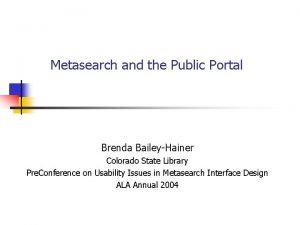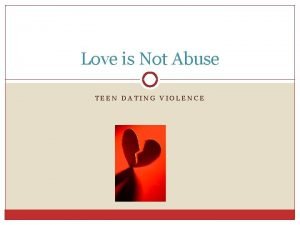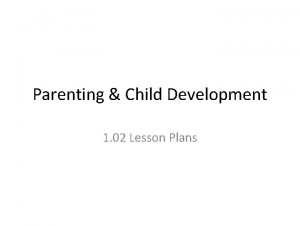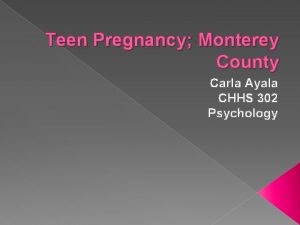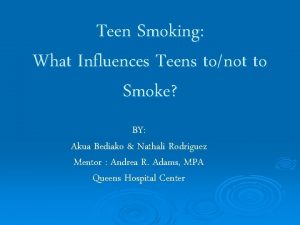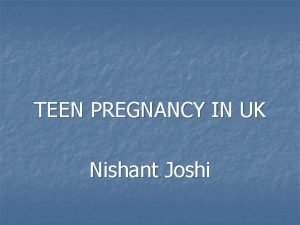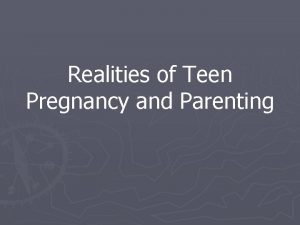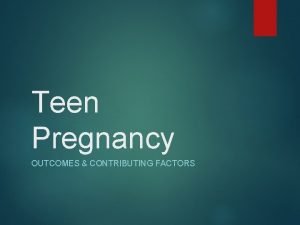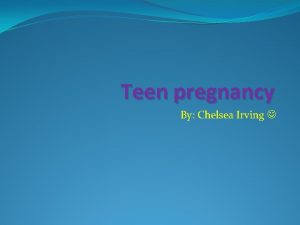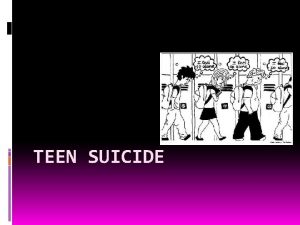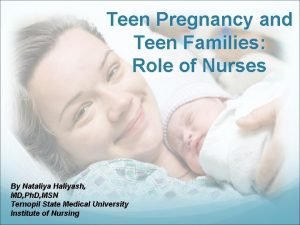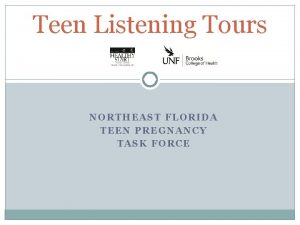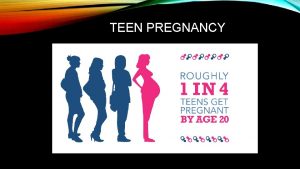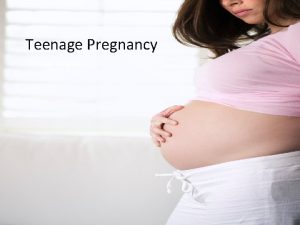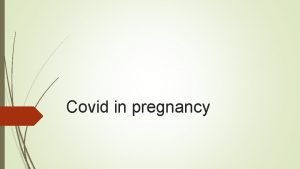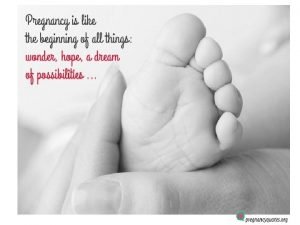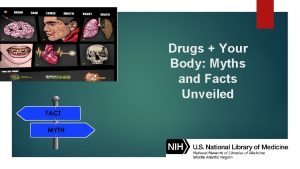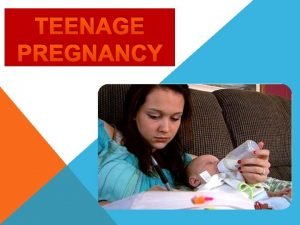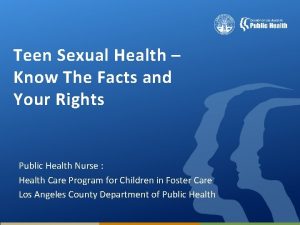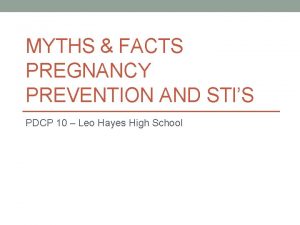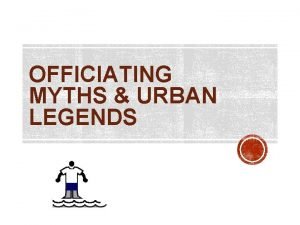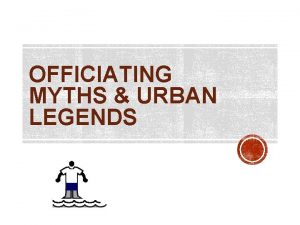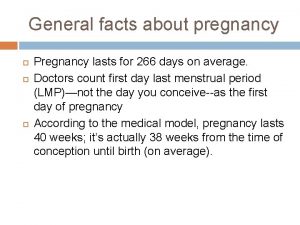Myths and Facts TEEN PREGNANCY MYTHS OF SEXUAL
































- Slides: 32

Myths and Facts TEEN PREGNANCY

MYTHS OF SEXUAL ACTIVITY

Everyone is doing it. Less than half of all high school students have ever had sex.

Girls never pressure guys to have sex; pressure always comes from the male. Pressure can come from anyone regardless of gender, sexual experience, or age.

You’ll marry the first person you have sex with. 8/10 first time teen sexual relationships last 6 months or less. ¼ are one-time occurrences.

Drinking and drugs make sex more fun. If you are drunk or high, you do not make good decisions. People are more likely to be the victims of rape when substance abuse mixes with sexual activity.

You cannot get pregnant the first time you have sex.

A girl cannot get pregnant is she is on her period. Sperm stays alive several days once in the vagina.

A girl can’t get pregnant if… You have sex standing up The girl is on top You have sex in a hot tub or a swimming pool You jump up and down immediately after sex The girl douches, takes a bath, or urinates immediately after sex It's your first time; You're both virgins The guy pulls out before he ejaculates or if he doesn't go all the way in The girl doesn't have an orgasm The guy and the girl don't orgasm at the same time The girl pushes really hard on her belly button after sex The girl makes herself sneeze for fifteen minutes after sex.

Wearing two condoms at once is double protection. If two condoms are worn at once, they will rub against each other, causing friction and a hole can rub into them, reducing your protection from STDs and pregnancy.

If you don’t have a condom, you can use a Ziploc bag.

As long as a girl takes the Pill right before sex, she’s protected. In order for the Birth Control Pill to be effective, it must be taken once a day, every day, at the same time.

The Pill is effective the first day a girl begins taking it. Birth Control Pills do not take effect until one month after a girl begins taking it.

TEENAGE PARENTS

WHAT DO YOU THINK ARE ISSUES FACING TEEN PARENTS?

Three out of ten teen girls in the US get pregnant at least once before age 20. That equals 745, 000 teen pregnancies each year.

The United Stages has the highest teen pregnancy rate in the industrialized world. Twice as high as England or Canada. 8 x as high as Japan.

Parenthood is the leading reason why teenage girls drop out of school. Less than half of teen mothers ever graduate from high school and fewer than 2% earn a college degree by age 30.

Pregnant teens are far less likely to receive timely and consistent prenatal care than those who get pregnant at a later age. Teen mothers are more likely to smoke during pregnancy.

Two-thirds of families begun by a young unmarried mother are poor. More than ½ of mothers on welfare had their first child as a teenager.

Teen mothers are likely to have a second birth relatively soon. ¼ of teen mothers have a second child within 24 months of the first birth.

8 out of 10 fathers do not marry the mother of their child. These absent fathers pay less than $800 per year for child support, often because they are poor themselves.

CHILDREN OF TEENAGE PARENTS

WHAT DO YOU THINK ARE ISSUES FACING CHILDREN OF TEEN PARENTS?

Children of teen mothers do worse in school than those born to older parents.

Children of teen mothers are more likely to be born prematurely and at a low birth weight.

Children of teen mothers are twice as likely to suffer abuse and neglect compare to children of older mothers.

Children who live apart from their fathers are 5 x more likely to be poor than children with both parents at home.

The daughters of young teenage mothers are 3 x more likely to be teen mothers themselves.

The sons of teenage mothers are twice as likely to end up in prison.

Children born to teen mothers are at higher risk of behavioral problems.

Sources http: //www. stayteen. org The Children of Teen Parents Fact Sheet. FSU Center for Prevention & Early Intervention Policy.
 Whitchester house
Whitchester house Spotting in pregnancy
Spotting in pregnancy Hurricanes myths and facts
Hurricanes myths and facts Multiplication facts and division facts
Multiplication facts and division facts Myths and legends quiz questions and answers
Myths and legends quiz questions and answers Picme2.0
Picme2.0 Youngteensporn
Youngteensporn Explorica teen tours
Explorica teen tours Teen power pmv
Teen power pmv Teen fads
Teen fads Veertig sinkplate
Veertig sinkplate Teen portal nn
Teen portal nn Safety plan teen
Safety plan teen Most fad diets do follow the mypyramid guidelines.
Most fad diets do follow the mypyramid guidelines. Gauravkumar13
Gauravkumar13 Teen nn
Teen nn Teen movie genres
Teen movie genres Teen challenge mission statement
Teen challenge mission statement Sexual wholeness toolkit
Sexual wholeness toolkit Which illustrates an emotional aspect of teen sexuality?
Which illustrates an emotional aspect of teen sexuality? Teencoin
Teencoin Teenbiz
Teenbiz Teen film genre
Teen film genre Territorio teen
Territorio teen Teen challenge monterey bay
Teen challenge monterey bay Teen brain claims
Teen brain claims Teen traps
Teen traps Teen marvel melissa
Teen marvel melissa Teen biblio therapy
Teen biblio therapy Eustress example
Eustress example Teen vvv
Teen vvv Teen nnn
Teen nnn Corey wittig
Corey wittig











